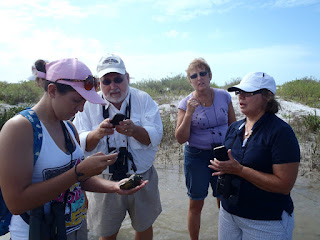On Friday we took the 2nd field trip of our
Florida Master Naturalist-Coastal Module. Thanks to the generous support of
FishTale Marina we went out on one of their boats to do a little bird watching in the Estero Bay area. It was a great opportunity to see several wading and waterbirds as well as learn about a variety of human-use issues in the area (e.g. poll & troll zones, shorebird nesting areas, renourishment projects etc.). Of course, I can't leave out that we also saw manatees and dolphins! We couldn't have asked for better weather! After exploring the bay Captain Jay took our group to the southern end of Ft. Myers Beach where we did a little beach and lagoon exploration. We found crown conchs, blue crabs, fiddler crabs, lightning whelks, and worm egg sacks to name a few. Below is a list of birds we saw and several pictures from our trip. Enjoy!
(March 9th, 2012 Bird List)
Osprey, bald eagle, brown pelican, kingfisher, grackle spp., wood stork, great egret, reddish egret, snowy egret, great blue heron, little blue heron, tri-colored heron, white ibis, red breasted merganser, double crested cormorant, anhinga, ring billed gull, laughing gull, royal turn, ruddy turnstone, black vulture, turkey vulture, palm warbler, and mocking bird.
 |
| Studens looking for a manatee spotted by some of the boat slips. |
 |
| Joy giving the group an overview of what we'll be doing for the day. |
 |
| Our class checking out some red breasted mergansers in Estero Bay. |
 |
| Scouting out the mud flat up ahead for shorebirds |
 |
| Joy explains to the group about proposed "poll and troll" zones to protect the bay's seagrass communities. |
 |
| Captain Jay talks to our students about the dolphins commonly seen in the Estero Bay area |
 |
Just a few of our feathery friends we saw while out on the water
(brown pelicans, cormorants, ruddy turnstones, and laughing gulls) |
 |
| The group checking out some dolphins in the bay. |
 |
| Several bald eagles were spotted on Lovers Key. Joy is pointing out their next. |
 |
| Lagoon and beach habitat on Ft. Myers beach |
 |
| Exploration time! |
 |
| I show the group a polychaete (marine worm) egg sack |
 |
| A patch of shoal grass in the lagoon |
 |
| A nice sized crown conch |
 |
| Some young black mangroves that have established themselves along the shoreline |
 |
| Nice lightning whelk! |
 |
| Exploring the flats |
 |
| Pneumatophores associated with black mangroves |
 |
| Its not a field trip unless you get to hold a blue crab!!!!!! |











































